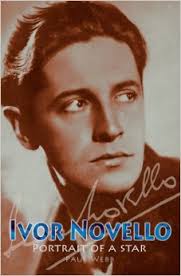 Ivor Novello: Portrait of a Star
Ivor Novello: Portrait of a Star
by Paul Webb
Haus Books (London)
208 pages, $24.95
THE NAME “Ivor Novello” is perhaps only recognized on these shores by those Robert Altman movie fans who saw the director’s stylish British manor house whodunit Gosford Park (2001). In it, the dashing Jeremy Northam plays a movie star of the early 1930’s who’s a weekend guest at an English country estate. Altman’s main interest is the “upstairs/downstairs” drama of the fictional guests and their domestics, all ending in the host’s murder. But Northam’s character, entertaining himself at the piano, the object of every servant girl’s adoration, is a portrayal of a real English heartthrob, Ivor Novello.
A silent film star whose most notable film appearance was in Hitchcock’s The Lodger (1926), Novello had already composed at age 21 the home front “anthem” for World War I soldiers, 1914’s “Keep the Home Fires Burning.” Its broad popularity made him rich and famous. During his acting career, he wrote popular music for the London theatre and would eventually appear in many stage productions of his own devising from the 1930’s through the 1940’s. Lastly, Novello was famously beautiful. He was a darkly exotic icon of interwar glamour matched in Britain only by his junior and competitor, Noël Coward, who’s reported to have said, “There are two perfect things in this world. My mind and Ivor’s profile.”
 It is difficult to judge what interest such a remote figure might have to an American audience, even to gay enthusiasts eager for information about the queer influence in musical theatre, silent films, and early talking pictures. As one might have guessed, Welsh-born Ivor Novello—David Ivor Davies at his christening—was decidedly “that way.” This, despite becoming the favored sex object of many a beguiled English girl—or of her mother hoping to snare an eligible son-in-law. Even one of London’s great stage beauties of the era, the peerless Gladys Cooper (in her old age, Henry Higgins’ mother in the film My Fair Lady), for a time envisioned herself in love with Novello, and their gorgeous pairing on stage and screen fueled box-office receipts.
It is difficult to judge what interest such a remote figure might have to an American audience, even to gay enthusiasts eager for information about the queer influence in musical theatre, silent films, and early talking pictures. As one might have guessed, Welsh-born Ivor Novello—David Ivor Davies at his christening—was decidedly “that way.” This, despite becoming the favored sex object of many a beguiled English girl—or of her mother hoping to snare an eligible son-in-law. Even one of London’s great stage beauties of the era, the peerless Gladys Cooper (in her old age, Henry Higgins’ mother in the film My Fair Lady), for a time envisioned herself in love with Novello, and their gorgeous pairing on stage and screen fueled box-office receipts.
The ingredients of Novello’s life are certainly interesting enough to warrant a detailed biography. But Paul Webb’s book is more the work of a well-informed fan than of an engaged cultural historian. While he gives us the names and dates of every movie and stage play, and fires off breathless résumés of each, and tells us who co-starred, he is largely indifferent to the mores, styles, and psychology of the period under review. To be sure, Webb can quickly dispense with such matters by giving a pithy account of the Zeitgeist, to wit: “homosexuality was not mentioned in the 1920’s in the way that it is now. As well as being socially unacceptable, it was, of course, illegal. … The second reason for Ivor’s private life being unknown was the vastly less intrusive press of those days. Open secrets in Society circles were kept very much to those circles.” What’s missing here is any inquiry into the recent history that had forced homosexuality into this particular closet. Novello’s generation came of age only two decades after the Oscar Wilde trials. What’s remarkable is not so much the secrecy of this generation as its continuing influence on the popular culture, with Ivor Novello its chief avatar in theatre, in song, and in movies. (However, Webb acknowledges that Noël Coward has had a more lasting influence, in part because he lived into the 1970’s while Novello died in 1951.)
Also absent—and sorely missed by those of us who aren’t British and don’t have the prior background that’s assumed—is any serious discussion of th e kinds of theatrical and musical traditions that would have been brought to bear on Novello’s creative output. There’s no mention of the English Music Hall; nor does the work of Gilbert and Sullivan make an appearance, though light opera and Franz Lehár are given passing comment. Webb never attempts to compare Novello’s musical output to American contemporaries like Cole Porter, the Gershwins, or Rodgers and Hart. It is not sufficient to read that he was “heavily influenced by Puccini and Lehár—and loved Wagner” and basically leave it at that. Furthermore, we do not get a vivid picture of the wider London theatre world of the 1910’s, 20’s, and 30’s, other than the corner of it occupied by Novello and his favored players.
e kinds of theatrical and musical traditions that would have been brought to bear on Novello’s creative output. There’s no mention of the English Music Hall; nor does the work of Gilbert and Sullivan make an appearance, though light opera and Franz Lehár are given passing comment. Webb never attempts to compare Novello’s musical output to American contemporaries like Cole Porter, the Gershwins, or Rodgers and Hart. It is not sufficient to read that he was “heavily influenced by Puccini and Lehár—and loved Wagner” and basically leave it at that. Furthermore, we do not get a vivid picture of the wider London theatre world of the 1910’s, 20’s, and 30’s, other than the corner of it occupied by Novello and his favored players.
We do learn that he crafted popular musical confections in which Ruritanian royalty fall in love with unavailable maidens or opera singers, with titles like Perchance to Dream, Careless Rapture, and Crest of the Wave. And while Webb is judicious in crediting the best of Novello’s theatrical output, it might have been worthwhile to disclose (or even speculate on) the extent to which such light fare was part of a widespread flight from the horrors of the Great War, whether any alternate theatrical styles kept London’s West End amused, and against what waves of serious dramatic endeavor these escapist and highly commercial entertainments navigated.
Webb sympathetically defends Novello’s apolitical personality and creative output; only one of his musical theatre plays, The Dancing Years (1939), subtly acknowledged the gathering storm of the next world war. And it is certainly amusing to get quick glimpses of stage and silver screen royalty who flit across these pages; Novello knew everyone from Vivien Leigh to Greta Garbo. But the reader quickly realizes that this book is hardly a deep exploration of Ivor Novello, when even his lifelong male partner is given the same short shrift as those with cameo roles. Only in the early chapters is Novello’s mother, Dame Clara Novello Davies, a powerhouse on the order of “Mama Rose” from Gypsy, accorded something that might constitute a three-dimensional portrait.
The author laments that there has been no serious revival of interest in Novello despite the wildly popular musical output of his career. Sad to report, this book, which may have been written to kick off such a campaign, lacks the necessary weight to encourage that to happen, at least on this side of the pond.
Allen Ellenzweig, a frequent contributor to this journal, is the author of The Homoerotic Photograph.





